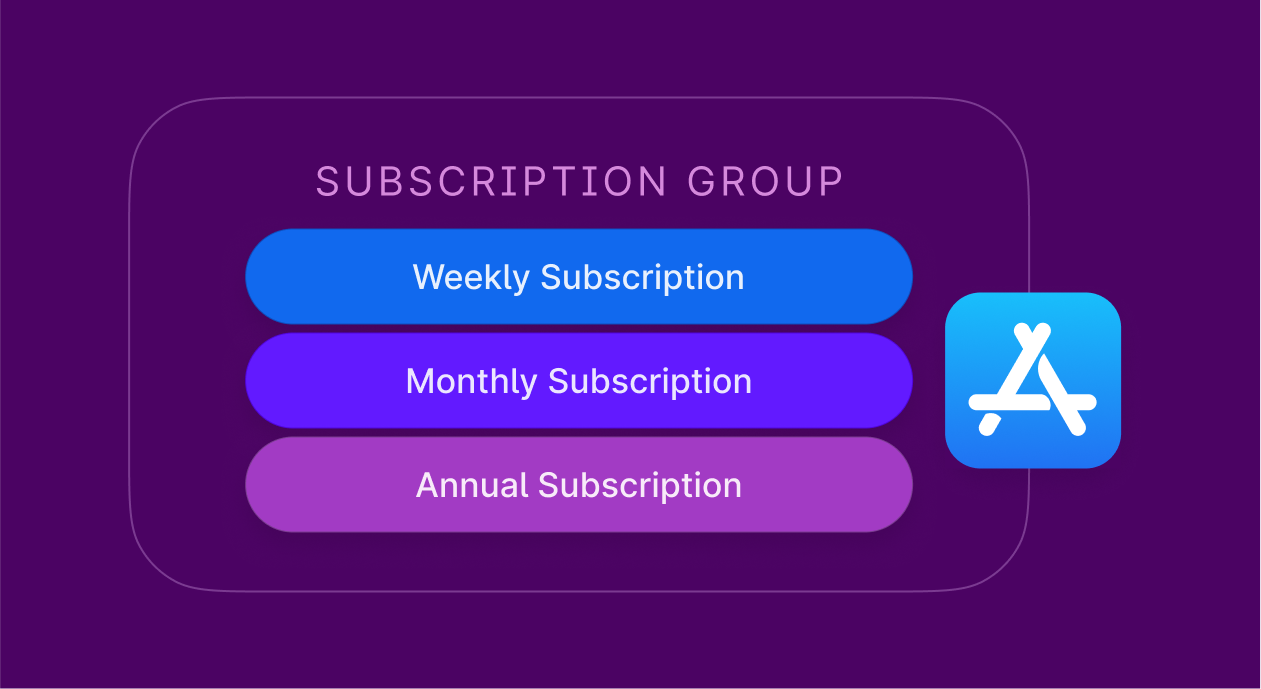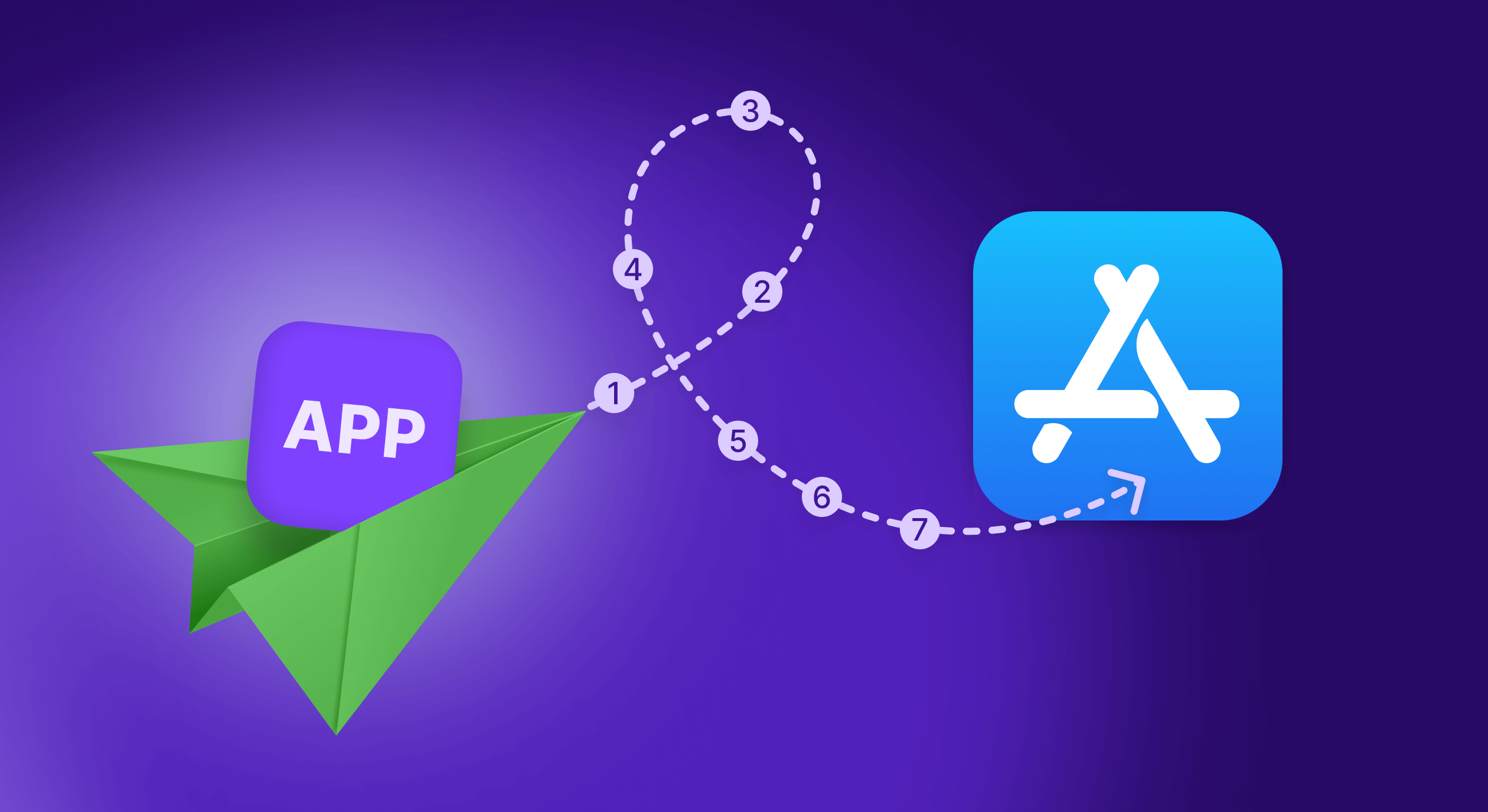Step-by-step app funnel analysis guide

Updated: July 26, 2024
24 min read
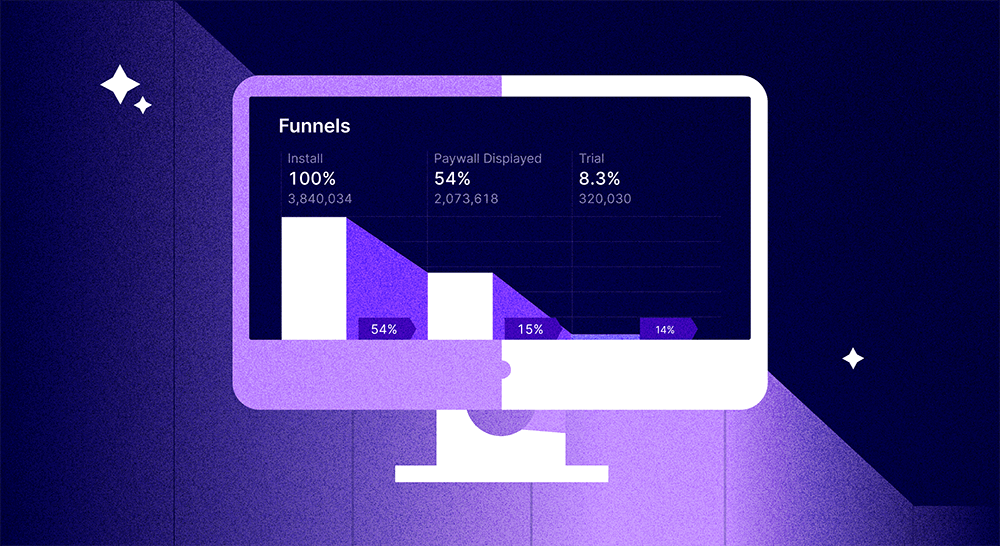
App funnel analysis is the process of visualizing your users’ journey with your app so you can “see” how your users engage with it, right from the moment they discover and download it all the way to making in-app purchases or renewing (or canceling!) their subscriptions. By analyzing your mobile app’s funnel, you can identify areas where users abandon their buying journey and optimize them to improve retention.
In addition to zooming in on where you lose the most of your users, app funnel analytics also provides insights into the entire lifecycle of your different app user segments, showing you what user journeys convert the best, who your best and most loyal users (more so, user segments) are, and which user segments offer the best lifetime value, among other things.
In this mobile app funnel guide, we’ll see what an app funnel is, how it can look different for different apps depending on the monetization model they use, the various stages of the mobile app funnel, how to add app funnel analytics to your mobile app marketing mix, and a few best practices when doing so. But first, let’s look more closely at the app funnel.
What is an app funnel?
Simply put, a mobile app funnel maps a user’s journey with a mobile app right from the point they discover it—via a search in the app store or through a Facebook ad or a PR story—to converting. App funnels include stages of the app user lifecycle, such as the initial app install, in-app purchases, and other desired in-app actions (like inviting a friend to try the app). Understanding and optimizing your app funnel helps you improve app user acquisition, engagement, and retention.
Depending on an app’s monetization model, its conversion funnel analysis can look very different.
For example, for a paid-to-download app where users need to pay to download (the paid app share sits at 3% in Google Play and 5.5% in the App Store, by the way), the app user pretty much completes their journey by making the payment on the app store. Unless it’s a subscription app where users must make recurring payments based on their subscription plan, the app user journey ends with the purchase. Roughly, here’s what this user journey looks like:
- First, users discover the app. (App discovery!)
- Next, they land on the app’s listing and decide if they want to purchase. (This is the consideration stage.)
- Finally, they purchase and download the app or abandon their buying journey. (As noted above, the user journey doesn’t end here if it’s a subscription app. Otherwise, this is the final conversion stage.)
The app funnel for this app is pretty simple.
In contrast, the app funnel goes beyond the download stage for an app that offers a free trial. Say, if an app offers a 7-day trial, the conversion event only happens when the app user is actually billed at the end of the free trial. So here, the app user:
- discovers the app
- decides to download it
- downloads it
- “tries” the app
- and chooses to migrate to the paid plan (by not canceling the trial during the trial period).
As you can tell, the conversion funnel analysis of such apps that offer trials looks quite different, with several additional stages.
Funnel analytics looks even more different for a freemium app with an in-app purchase that unlocks the premium version. Here, users start by discovering the app, installing it, and then hitting the paywall at some point. You’re likely looking at the following funnel in this case:

But what if this freemium app used the subscription model and offered a free trial? In this case, you’d be looking at even more stages in its app funnel. Below, you can see Adapty showing the funnel for such a freemium subscription app that also offers a trial:
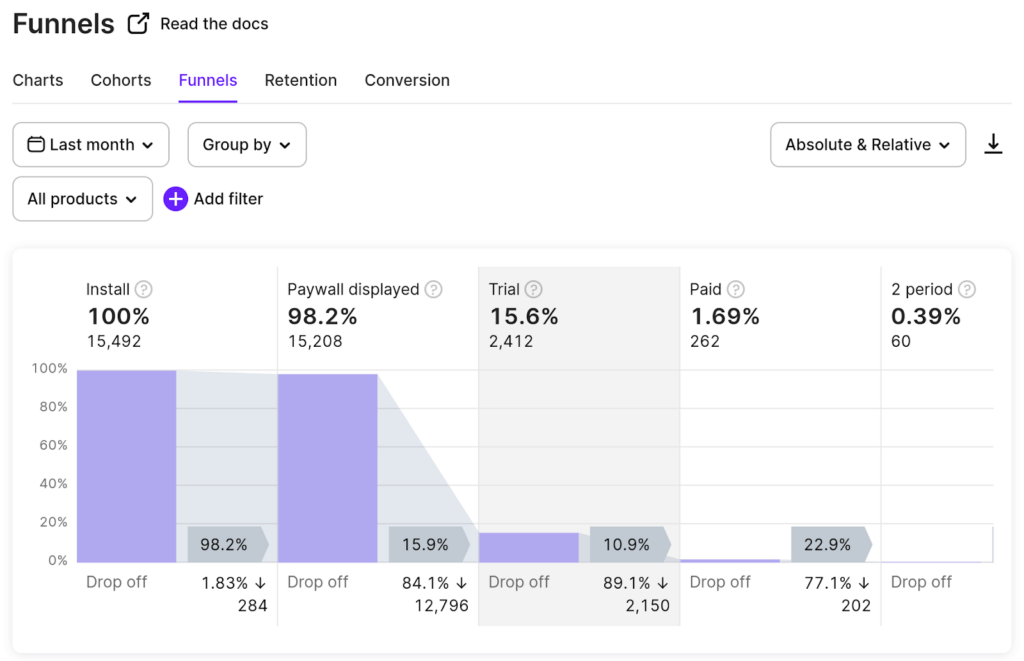
You get the drift.
Let’s now look in detail at the various stages of the mobile app funnel.
Mobile app funnel phases
Before we get to the different stages of a mobile app funnel, let’s discuss its three phases, each including a couple of stages.
Acquisition
Stages like app discovery, consideration, and conversion fall in the acquisition phase of the mobile app funnel. These stages involve bringing people to your app store listings and getting them to download your app.
Engagement
This mobile app phase/stage deals with everything from onboarding (which includes steps like user signup, registration, and completion of a few in-app actions) and app usage to in-app spending.
Retention
Retention is a bottom-funnel phase/ stage where you try to convert your app users into users for life and encourage repeat purchases and boost long-view metrics like your customer lifetime value. Here’s a closer look at the different mobile app funnel stages.
Mobile app funnel stages
Acquisition
The acquisition stage of the mobile app funnel shows you how you acquire new app users. There are several substages to the acquisition stage.
First comes app discovery. Before users download and install your app, they probably discover it somewhere—perhaps through organic search, a paid ad, or a news story. If you see that you’re failing to bring a decent traffic volume to your Google Play or App Store app listing—metrics like your app store listing views give you this data—you might want to work on your app discovery channels.
In a 2015 study, Google found that the top three ways people discovered new apps were: 1) through their friends, family, and colleagues (52%), 2) inside the app store (40%), and 3) from search engines (27%).
The app store channel can be the one you start with. Since app discovery happens via ads or organically, you can do both (run ad campaigns and invest in app store optimization). Generally, the more high-quality traffic you bring to this top-funnel stage, the more users will enter your funnel.

Next comes consideration. This is when a potential new app user decides if they want to get your app. Your app store listing is a crucial acquisition or consideration touchpoint because while the organic listing or ad or PR story got the user to the listing, they still need to decide if they want to download based on your listing.
When it comes to the consideration substage of the acquisition phase, your app listing does all the work. Google’s research found that while downloading an app, users pretty much consider everything that lives on the app listing, including:
- App description
- Pricing
- Ratings
- Reviews
- Factors like a free trial
If you find that a lot of potential new users hit your app’s listing on Google Play or the App Store—you can easily get these stats—but you see low downloads, it might indicate a problem with the app listing. If you feel that your app’s description isn’t connecting with your users, you can run an A/B test on the copy, graphics, and other elements of your app listing and optimize it for more conversions. Both Google Play and Apple’s App Store let you run A/B tests on your app listing to maximize conversions.
Reacquisitions, too, are part of the acquisition stage. If you’ve got app users who have gone dormant or have canceled their subscriptions, you can launch push notifications, emails, and ad campaigns to reacquire them.
Google has found that about 24% of users who abandon an app can be reacquired through exclusive content, another 30% can return if offered a discount toward the next purchase, and yet another 16% can be recovered with notifications of new features.
Conversion
The conversion stage of a mobile app deals with app downloads/installs and signups.
Users who decide to hit the install/download button at the acquisition stage get to the conversion stage.
Again, depending on an app’s monetization model, the conversion stage can look different for different apps. You may need to track several conversion rates in your app funnel. Here’s what we mean:
If a user downloads a free-to-download app that needs the user to sign up for a free trial and agree to migrate to a paid plan post the trial, the initial download won’t count as a conversion. You’d only get a conversion once the user actually successfully migrates to the paid plan post the trial by not using the trial cancellation feature.
To optimize the conversion stage, you need to choose strategies that make sense for your monetization model. For example, for such an app model, where the app offers a free trial, you might want to use a dedicated trial paywall inside your mobile app. Your trial paywall must explain to your users clearly how the trial works. The timeline mobile app paywall type is excellent for such an app model. You should also use clear CTAs on your paywall explaining how the billing begins immediately (and automatically) post the trial. With this model, the trial-to-paid metric is your actual conversion metric.

With the free trial model, you’ll also want to closely monitor the number of people who see the paywall vs. those who begin the trial. This is also one of the conversion rates you’ll track with your funnel analytics. This is your trial conversion rate. Optimizing your mobile app paywall can help boost this metric.
If this were a freemium app instead with a limited free and a premium version, you’d only count a conversion when a user saw your paywall and upgraded to the premium version. The initial download alone won’t truly reflect a conversion. In this case, while the download would count as a conversion, the true measure of success would be the number of users who get the premium version.
If, instead, this were a freemium app with one-off in-app purchases (like extra lives or levels in a game), conversions would look even more different.
Said another way, depending on an app’s monetization model, the conversion stage can look different for different apps.
Engagement
Users that complete the (initial) conversion stage, i.e., download an app and enter the engagement state.
In most cases, the engagement app funnel stage starts with app onboarding, or what Google calls the “virtual unboxing” of an app. Users typically download a bunch of apps to find the “right” one, so getting your onboarding model right for building the initial app engagement is essential. Check out our guide on mobile app onboarding and discover the top five mobile app onboarding models, along with examples and best practices for each.
If you offer a free trial with your app and see a massive dropoff from the trial to paid stage, the problem might be your onboarding, and fixing it could save some of the churn. You can tap tools like push notifications, in-app messaging, and emails to get your users to take advantage of the trial and unlock value so they stay. You can also put up a special offer, as getting a good deal is a key reason that gets free or freemium app users to convert. Putting up an offer paywall can also engage users to get a paid version.

You want to monitor how many users open your app as frequently as you’d like. For instance, if it’s a health or wellness app, you’d want users to access it daily. You could use push notifications to remind users to do their workouts and send tips on staying motivated. You could also use in-app messaging to help them track their progress and encourage them to celebrate milestones. You’d also need to perform a quantitative and qualitative analysis of how user sessions are going. Tools like UXCam are handy for gathering insights into app engagement.
Alternatively, if you offer a freemium app with a premium version, you might want to try different price points for your premium plans to find out what pricing works the best for your users. In addition to price testing, you can test other elements on your paywall, like its header or body copy, images, CTA, etc. Adding multiple paywall types can also work well. That’ll help you discover if a special offer paywall or a long-form paywall or a video paywall works well for you.
In-app purchases and actions that tie to conversions must also be monitored at this stage. So, for example, if you’ve seen that users who complete a specific action or set of steps end up making a purchase, you’d want to encourage this behavior. For an eCommerce app, it could be that users with longer browsing sessions make more in-app purchases. Learn how to encourage more of such behavior. Showing personalized products, feeds, offers, or exclusive incentives can help.
Yet another way to boost engagement (and conversions) here is to show your engaged users even more personalized offers via personalized paywalls. Check out our guide on mobile app paywall personalizations to learn more on this.
2024 subscription benchmarks and insights
Get your free copy of our latest subscription report to stay ahead in 2024.
Key metrics for app funnels analysis
Different stages of the mobile app funnel need tracking of different metrics.
For the top of the funnel, user acquisition metrics such as impressions, views, and downloads are essential to track. Here are some of the metrics to track for analyzing the acquisition stage:
- Traffic metrics: You should track the traffic to your app listings and their sources.
- App store conversion rates: This number tells you how well your app store listings are converting. This metric gives you the percentage of users who install your app after visiting your listing or impression.
- App installs: This is the number of installs your app gets over a period. For free apps, this is mostly only a top-funnel conversion metric. It must tie to eventual in-app purchases to generate revenue (or advertising revenue for ad-based monetization).
Once users enter the funnel, engagement metrics such as session length, frequency, and stickiness become more relevant. Here are some of the metrics to review at this stage of the funnel:
- Onboarding completion rate
- In-app actions that tie to in-app conversions
- In-app purchases
- Daily Active Users
- Session length
- Session frequency
Finally, at the bottom of the funnel, conversion metrics such as purchases, repeat purchases, and subscriptions should be monitored closely.
- In-app purchases
- Revenue
- Subscription metrics. (Metrics like Install → Trial, Trial → Paid, and Install → Paid help here. You’d also want to know how users drop off along their subscription lifecycle. So, data like the conversion rate between the second and third and third and fourth subscription payments (and so on) must also be recorded.
- Customer LTV
- Customer loyalty
Churn/drop-offs must be measured at all the funnel touchpoints.
Best practices for app funnels analysis
User segmentation
To truly decode your app user behavior with funnel analytics, you must drill down to the segment level. Why? Because different user segments behave differently.
By segmenting users based on demographics, behaviors, and other characteristics, you can see how each segment traces a unique journey with your app. Once you know that, you can offer each a better and more personalized app experience. For example, if you’re an eCommerce app, such analytics can tell you if users from a specific country are budget buyers and if incentives could be a good way to retain them.
Likewise, comparing segments of converting users with those that abandon or cancel can help identify factors that drive users to convert.
App growth experiments
Analyzing app funnels helps identify areas that can be optimized. For instance, if funnel analytics for an app show that most users drop off after downloading the app, it could indicate that the app is not delivering on the promise made in the app store description. An experiment on the app listing can help here. This might also hint at a complex onboarding process. And so, experimenting with onboarding might help.
Likewise, if users aren’t making in-app purchases, it might indicate pricing issues. Experiments can help get the pricing point right for your in-app purchases. Experiments can also reveal if throwing in incentives can help boost revenue. If funnel analysis shows many people hitting the paywall but failing to convert, the paywall might need to be optimized. Mobile app paywall A/B tests can help here.
High or unusual churn during a specific period, say during the third subscription cycle, might indicate engagement issues. With some qualitative and quantitative research, you can hypothesize experiments to keep users at this point.
Personalizations
Once you understand the unique user behavior your different user segments exhibit, you can launch personalizations to convert more of them. Such personalizations can be in the form of targeted marketing campaigns (think personalized in-app messaging, push notifications, or email communications), customized product offers (like offering a free trial on a plan that will resonate the best with them), or tailored messaging throughout the app. These efforts can help increase engagement and loyalty among your user base. Paywall personalization is a great way to use personalization for app growth. Check out our guide on mobile app paywall personalizations to see how to get started with this.
Meet Adapty
If you’re looking to analyze your app’s revenue funnel, check out Adapty. Adapty traces your user’s journey with you right from the time they install your app until churning. Here’s Adapty reporting the app funnel for a subscription app:
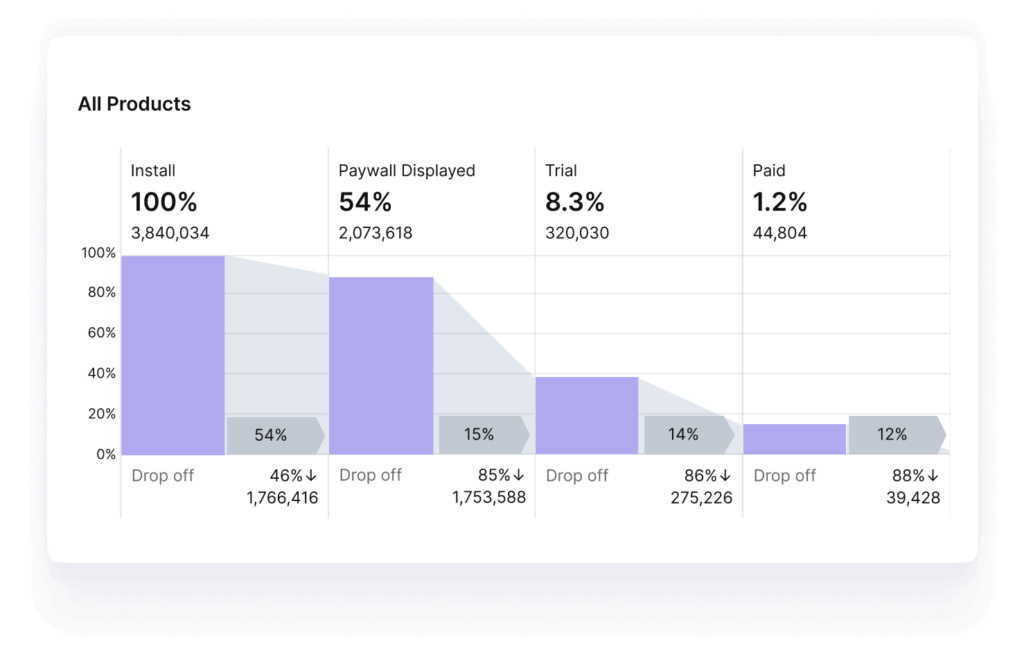
With Adapty, you can view your funnel data across any timeline. Looking at it over a year can show how your users behave over a year.
You can also group your funnel data according to Products, Countries, Stores, Paywalls, and Durations. This lets you see, for instance, how your App Store users compare with your Google Play users and what their conversion journeys look like. You can also see your conversion revenue funnel at the product level. Just choose a product and see how its funnel goes. The insights you learn here can help you design more optimal products. Segmenting funnel data using countries can give you the behavioral profile of your various target demographics.
Since Adapty lets you see the funnel data at the paywall level as well, you can find what paywalls resonate the best with your users and get the most conversions.
Conclusion
As you just saw, app funnels are an excellent tool for analyzing an app’s performance. Adding app funnel analytics to your mobile app mix doesn’t just help you visualize your user journeys and discover the issues that cause the most drop-offs but also shows you opportunities for optimization.
Seeing your users move through the funnel gives you the data you can use to hypothesize experiments on your app store listings, paywalls, onboarding, offers, and more.
Moreover, when you use a mobile app subscription analytics solution like Adapty that comes with funnel analysis, you can drill down your funnel data at several levels. For example, if you want to find out if you’re making loyal users in a specific country, simply select the country filter, and there you’ve all the data you need. If you realize users from a particular region are more loyal and stay the longest with you, you can invest more in your acquisition campaigns in the area. You get the idea.
If you want to get started with app funnel analytics, check out Adapty. Adapty offers some best-in-class mobile app revenue/subscription analytics and ships with a built-in funnel analysis feature. At its core, Adapty lets you add in-app purchases to your Android and IOS apps. Adapty also doubles up as a paywall builder and experimentation solution, enabling you to run A/B tests and other experiments on your paywall. You can also personalize your paywalls with Adapty. Sign up for a free trial.
FAQs
Recommended posts




